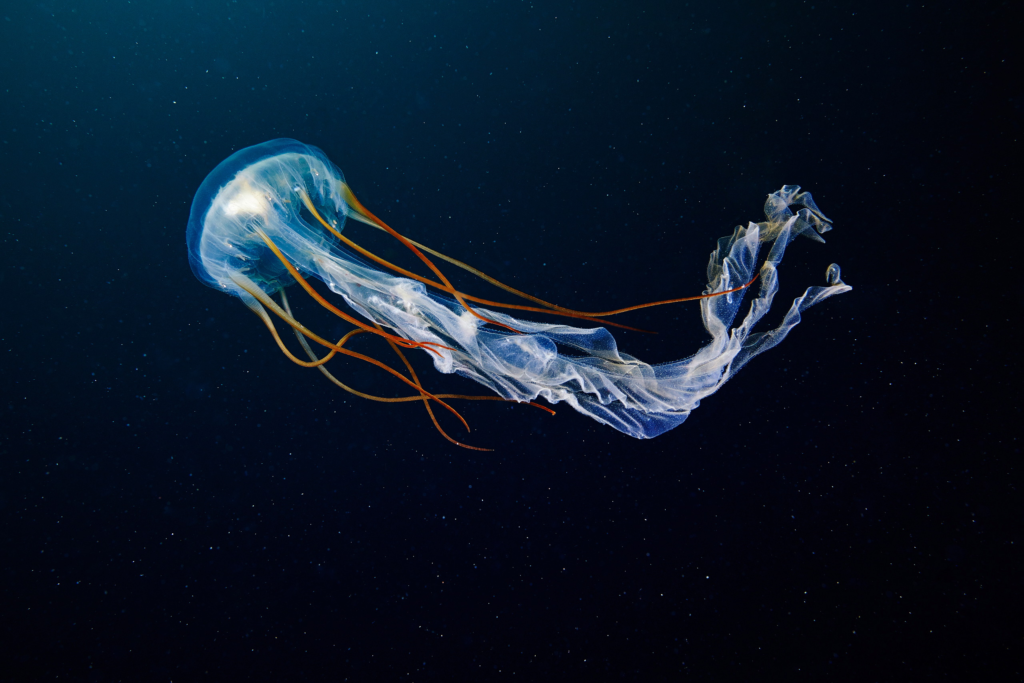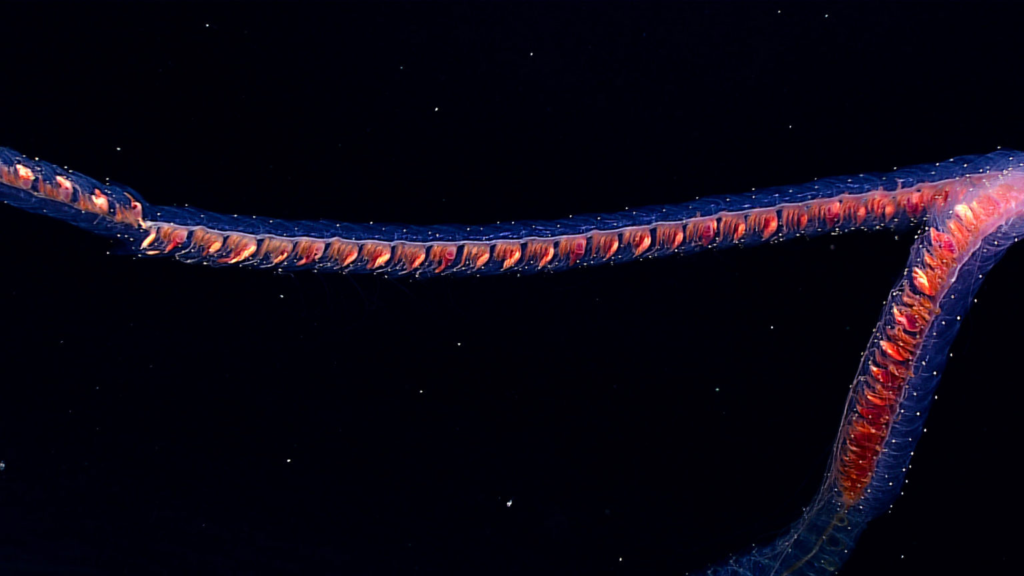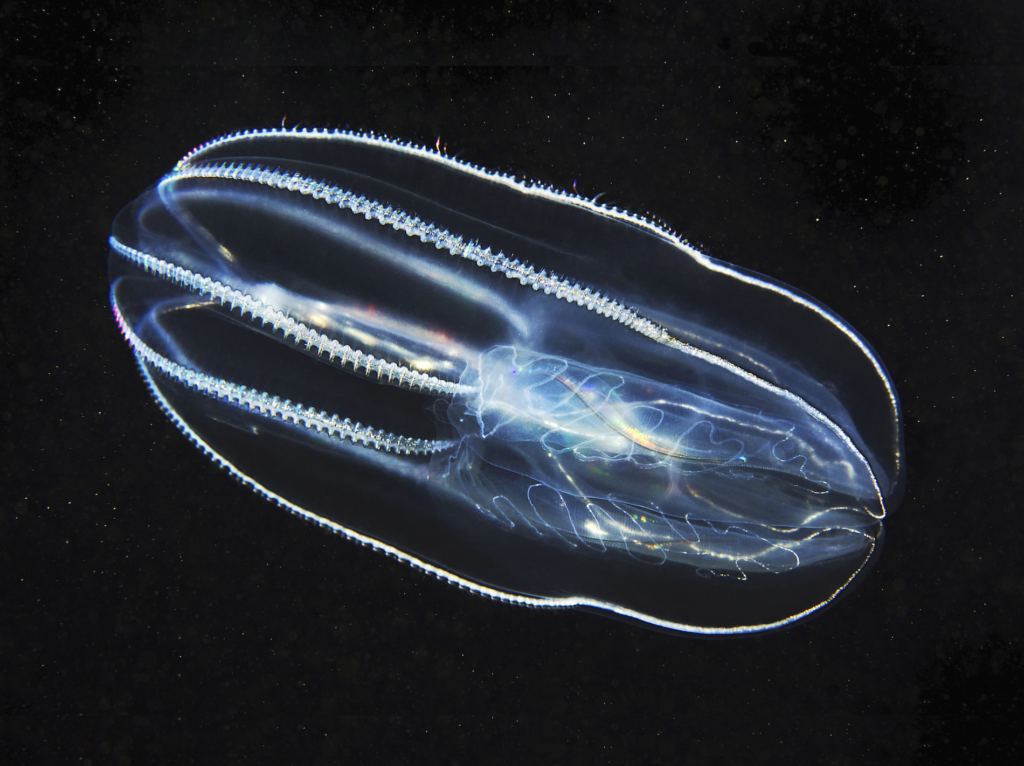Cnidarians and Ctenophores
Introduction
Cnidarians are a group of mainly marine animals that include jellyfish, sea anemones and corals. All members of this group are radially symmetric, they do not have a defined head and have special stinging cells called nematocysts which they can use to stun or kill prey and defend themselves from predators (Britannica, 2025). These animals have two main life stages; A polyp form which does not move, and a medusa form which can move. H0w long an individual spends in each stage depends on what type of cnidarian it is!
Scyphozoans

True jellyfish, also known as Scyphozoans, are a class of organisms. Their name comes from the Greek word ‘skyphos‘ which is a type of drinking cup as jellies have a cup-like shape. True jellies are different from others as the medusa life stage is the most prominent (Biology Libre texts, 2018). This means for most of the life cycle Scyphozoans are nekton and use sexual reproduction (polyps use asexual reproduction).
The Lions Mane is a type of Scyphozoan and is the largest jellyfish in the ocean! They get their name from their long, feathery tentacles which resemble a lion’s mane, and can grow up to 120ft (Ghosh, 2020). They come in all sizes and obviously can have very small stages which we see in our samples.
In a sample these will have a bell-shaped ‘body’ with lobbed edges, however the body will look different depending on how the organisms is orientated. They can be dark but may vary and sometimes have patterns. They will often have tenacles extending out from the ‘body’.
Hydromedusae

Hydromedusae are similar to Scyphozoans but differ as they are smaller, usually <1cm in size, and their polyp stage is more dominant, not the medusa stage (Purcell et all, 2013). They are the largest group of cnidarians.
They swim by contracting their bell to push them forward, this motion whips their tentacles through the water and can capture prey. All hydromedusae are predators, feeing on other, smaller zooplankton.
Most hydromedusae have a jelly fish appearance, being bell-shaped with many thin tentacles that are often long. Remember they can look different depending on what direction they are! Some can look unusual (left), but if you can identify the bell-shape and more than one tentacle it is a hydromedusae.
Siphonophores

Siphonophores get their name from the Greek word ‘siphon‘ meaning tube and ‘pherein‘ meaning to bear (as they all have a siphon). They are made up from individuals called ‘zooids’ which form colonies, each zooid has its own function within the colony (Johnson & Allen, 2012). The Portuguese man-of-war is a siphonophore!
They are a deep-sea species and some are bioluminescent, which is common for organisms that live in the bottom of the ocean! It is thought this helps them attract prey, such as small crustaceans, copepods and fish (Okeke, 2023). Certain species even have toxins and can cast a net of tentacles to sting and capture food. Sea turtles, jellyfish and some comb jellies eat Siphonophores.
They look long, narrow and may have a pointed head. Sometimes the narrow body can have other structures growing out from it. They have little pigmentation so appear lighter. As colonies grow, they can have one or more ‘swimming bells’, these can contract and push the organism through the water.
Ctenophores

Ctenophores are commonly called comb jellies as they have ciliary combs over their surface. The word ctenophore can be broken into ‘ctene’ meaning comb and ‘phore’ meaning bearer. All ctenophpores have rows of cilia, or ‘comb rows’ which they use to move, there is a chance they are the largest animals which use cilia for movement (Johnson & Allen,2012)!
In many ways they are similar to cnidaria, the main difference is that ctenophores do not have stinging cells and are harmless. However, they are sometimes bioluminescent in the dark and are very beautiful creatures.
They are mainly colorless, so will appear transparent but some will look darker. There are three main types found in samples, Cestid, tentaculate and lobate ctenephores.
Left; Cestids look flat and transparent, they almost have no features and have a belt-like appearance.
Middle; Tentaculates have comb rows running along their bodies with long tentacles that usually stretch longer than their bodies.
Right; Lobates have large lobes which they use for feeding. Some can be very dark and shaped like a thimble. Keep an eye out for the comb rows, these are sometimes visible.
Flash card Practice
References
Arctic Ocean Biodiversity. (n.d.). Pelagic Hydrozoa—Part 1. Retrieved March 26, 2025, from http://www.arcodiv.org/watercolumn/cnidarian/Hydromedusae.html
Biology LibreTexts. (2018, July 16). 28.2C: Class Scyphozoa. https://bio.libretexts.org/Bookshelves/Introductory_and_General_Biology/General_Biology_(Boundless)/28%3A_Invertebrates/28.02%3A_Phylum_Cnidaria/28.2C%3A_Class_Scyphozoa
ColdWater Science. (2017, September). Scyphozoan jellyfish (Chrysaora spp.) [Photograph]. http://coldwater.science/wp-content/uploads/2017/09/Scyphozoan-jellyfish-Chrysaora-spp-2.jpg
Encyclopædia Britannica. (2025, March 22). Cnidarian: Definition, life cycle, classes, & facts. https://www.britannica.com/animal/cnidarian
Ghosh, J. (2020, May 30). Lion’s mane jellyfish—Facts, size, weight, lifespan, pictures. Animal Spot. https://www.animalspot.net/lions-mane-jellyfish.html
Johnson, W. S., & Allen, D. M. (2005). Zooplankton of the Atlantic and Gulf coasts: A guide to their identification and ecology. Johns Hopkins University Press. http://archive.org/details/zooplanktonofatl0000unse
Kiddle. (n.d.). Siphonophorae facts for kids. Retrieved March 26, 2025, from https://kids.kiddle.co/Siphonophorae
La Recherche. (n.d.). Ctenophore (comb jelly) [Photograph]. Retrieved May 16, 2025, from https://www.larecherche.fr/sites/larecherche.fr/files/article_papier_field_image_paysage/Ctenophora_HD.jpg
NOAA Ocean Explorer. (2017, May 6). Deep-sea organism observed during Okeanos expedition [Photograph]. https://oceanexplorer.noaa.gov/okeanos/explorations/ex1705/dailyupdates/media/may6-3-800.jpg
Okeke, R. (2023, January 16). Giant siphonophore. A-Z Animals. https://a-z-animals.com/animals/giant-siphonophore/
Purcell, J. E., Baxter, E. J., & Fuentes, V. L. (2013). Jellyfish as products and problems of aquaculture. In G. Allan & G. Burnell (Eds.), Advances in aquaculture hatchery technology (pp. 404–430). Woodhead Publishing. https://doi.org/10.1533/9780857097460.2.404
Schmidt Ocean Institute. (n.d.). Deep-sea organism captured during research expedition [Photograph]. Retrieved May 16, 2025, from https://schmidtocean.org/wp-content/uploads/35643361823_8b2348a32a_o-1.jpg
Sheepadoodle.info. (n.d.). Scyphozoa: Facts, lifecycle, species, diet. Retrieved March 26, 2025, from https://www.sheepadoodle.info/2020/05/Scyphozoa.html
